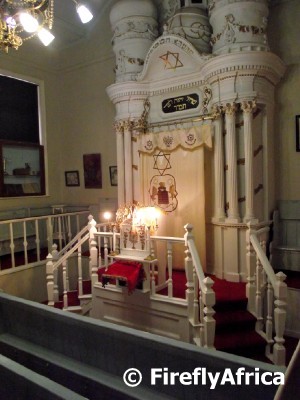The CP Nel Museum in Oudtshoorn is one of the top town museums in South Africa with a fantastic range of exhibits representing the history of the town and surrounding area. Most visitors pass through town on their way to the ostrich farms or Cango Caves and never see this Klein Karoo gem, but the few who do stop gets to learn so much more about the area.
The museum owes its origin to the private collection of colonel Charles Paul Leonard Nel, successful local businessman and collector of antiquities. He’s collection was so valuable that by 1938 it had received full recognition from the Historical Monument Commission. When he passed away in 1950 the newly constituted Board of Trustees took over administration of the collection. In 1972 the C.P. Nel collection was brought to its present home, the C.P. Nel Museum on Baron van Rheede Street. The sandstone building with its prominent clock tower was designed by Charles Bullock and erected in 1906 during the so-called second “ostrich feather boom”. Before the museum took it over it used to be the Oudtshoorn Boy’s High School and taking it over saved the building from demolition.
In the main hall the cultural and natural historic aspects of the ostrich are depicted. The exhibit takes visitors back to the ancient history of the ostrich where it was first discovered ten thousand years ago, carved into rock in the Sahara desert. The ostrich is known as the biggest bird in the world, but is unfortunately unable to fly because of its weight. It can run sixty to seventy km/h and weighs between ninety and a hundred kilograms. The collection includes a big variety of feathers and feather products, something that played a big roll in the early boom of Oudtshoorn.
As you walk through the museum you encounter a street scene that includes an unique chemist as it was known in 1895. The pharmacist himself mainly produced medicine making use of a Pill Machine, described as a pill roller and cutter.
The CP Nel Museum also boasts the only Synagogue to be situated in a museum with an Ark that is one of the tallest in South Africa. What makes the Synagogue so amazing is the fact that it’s still being used.
For those who appreciate the finer things in life, the museum’s collection of porcelain and glass will make a statement. The original designs of Willow-Pattern crockery (1850), Cranberry crockery (1880) and Earthenware, originating in Tzechoslovakai (1918) surely enjoy the attention of most tourists.
Even though there are so much more to see in the museum which also includes a natural history side, the last display I want to show is one of a typical 1911 sales store. Older folks would remember stores like this with the kids of today having never seen anything like it.
So next time you pass through Oudtshoorn for any reason, make sure you at least pop into the museum for a look at the town’s fascinating past.





